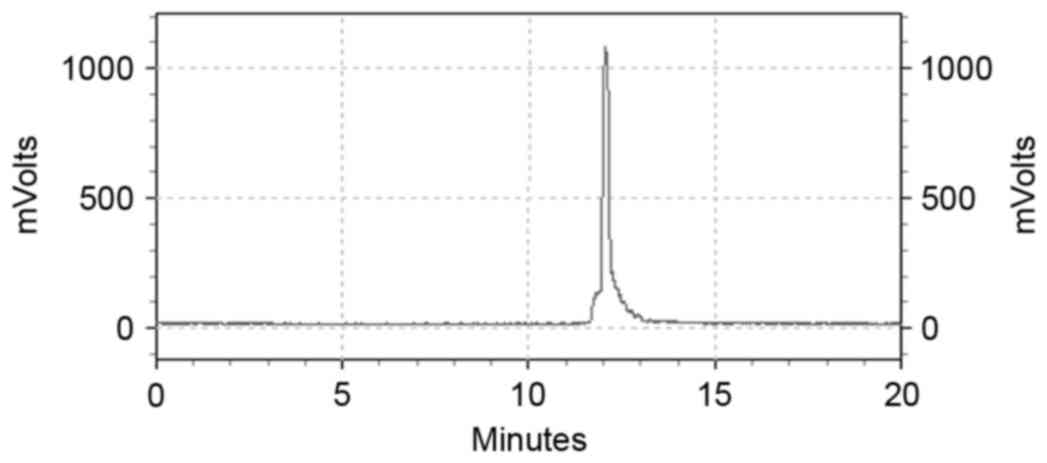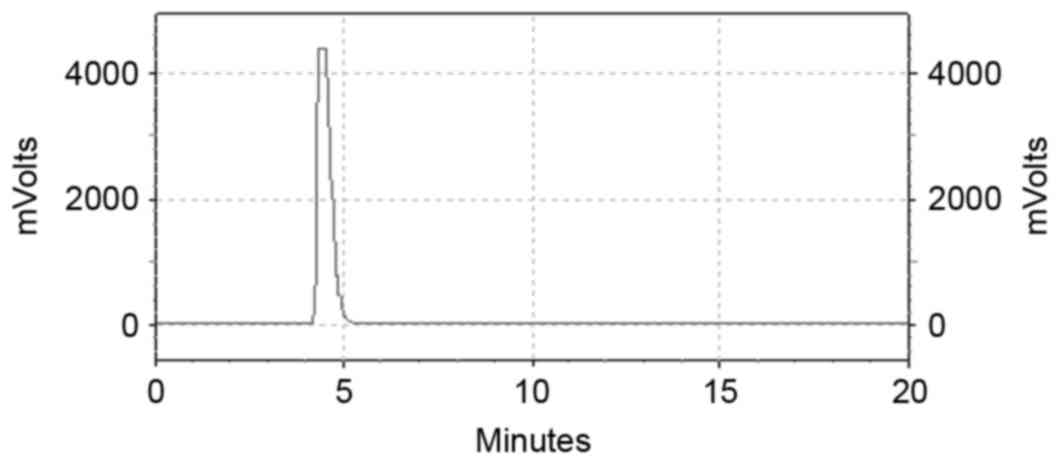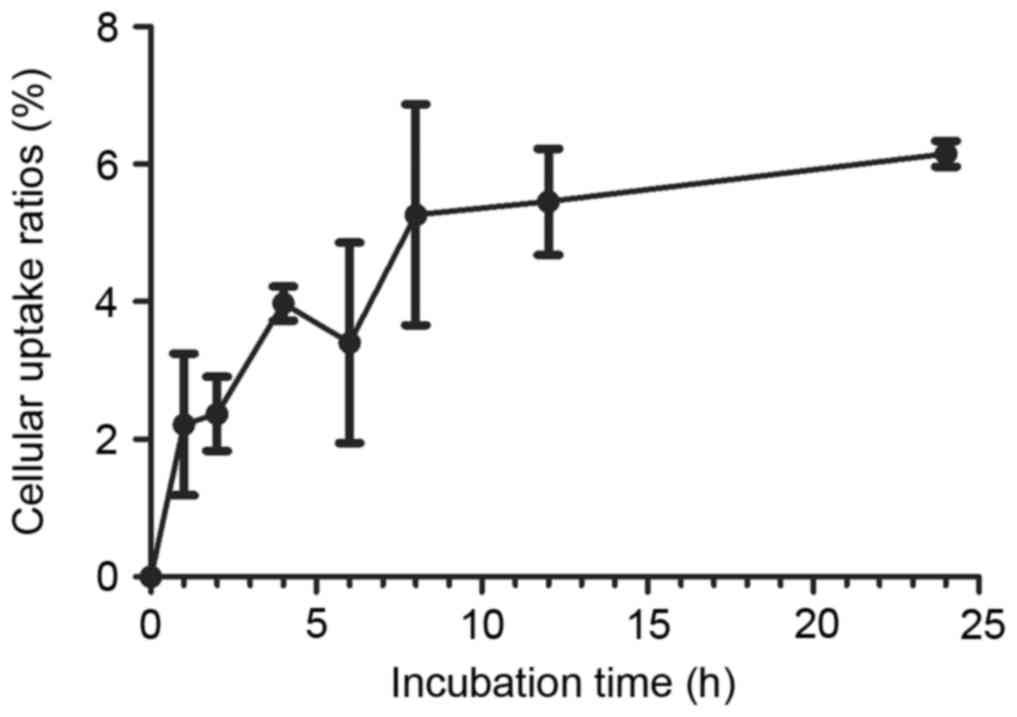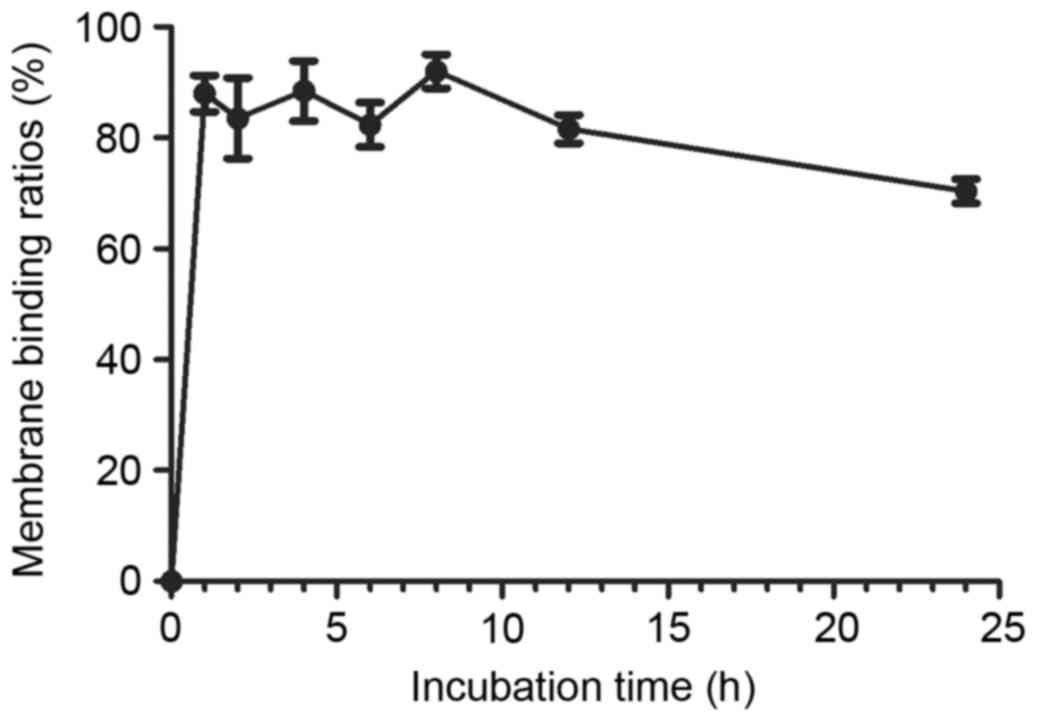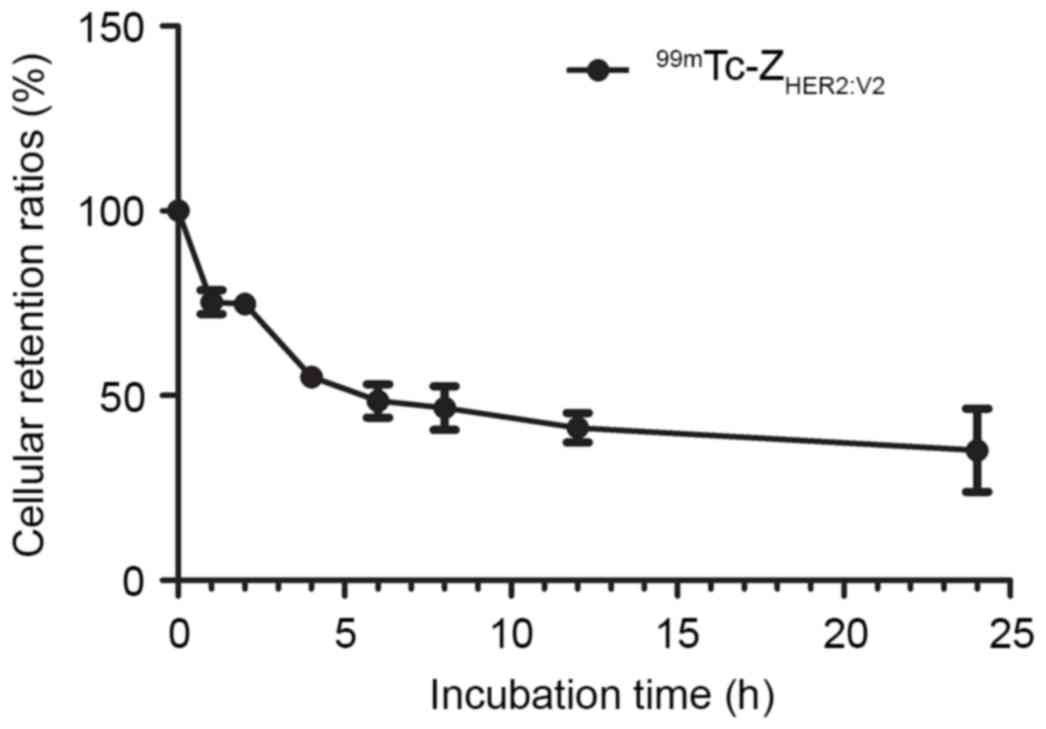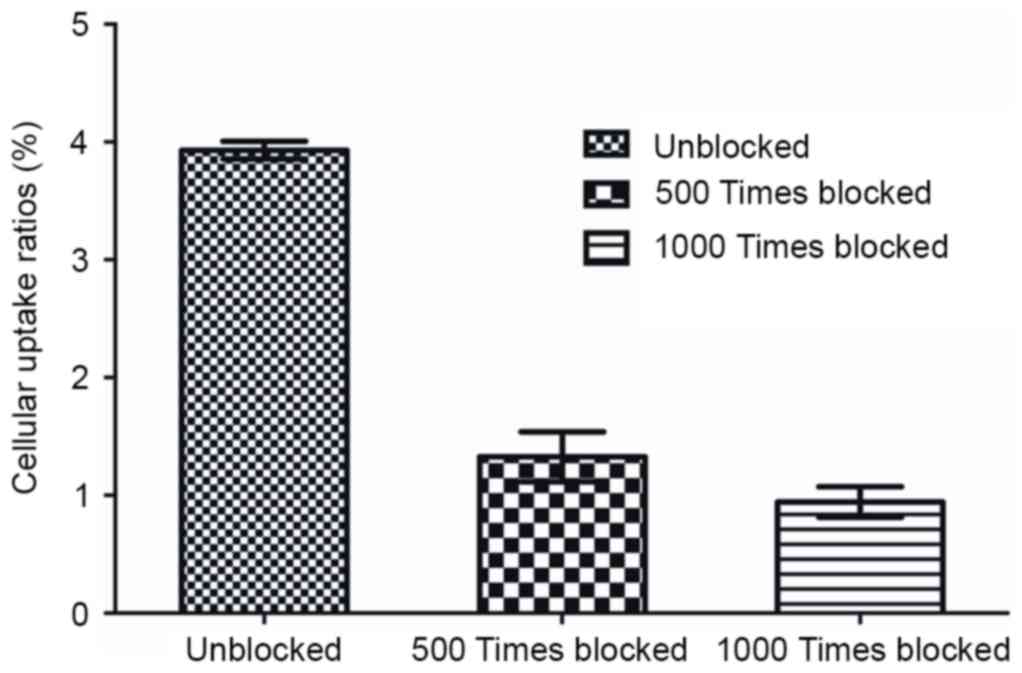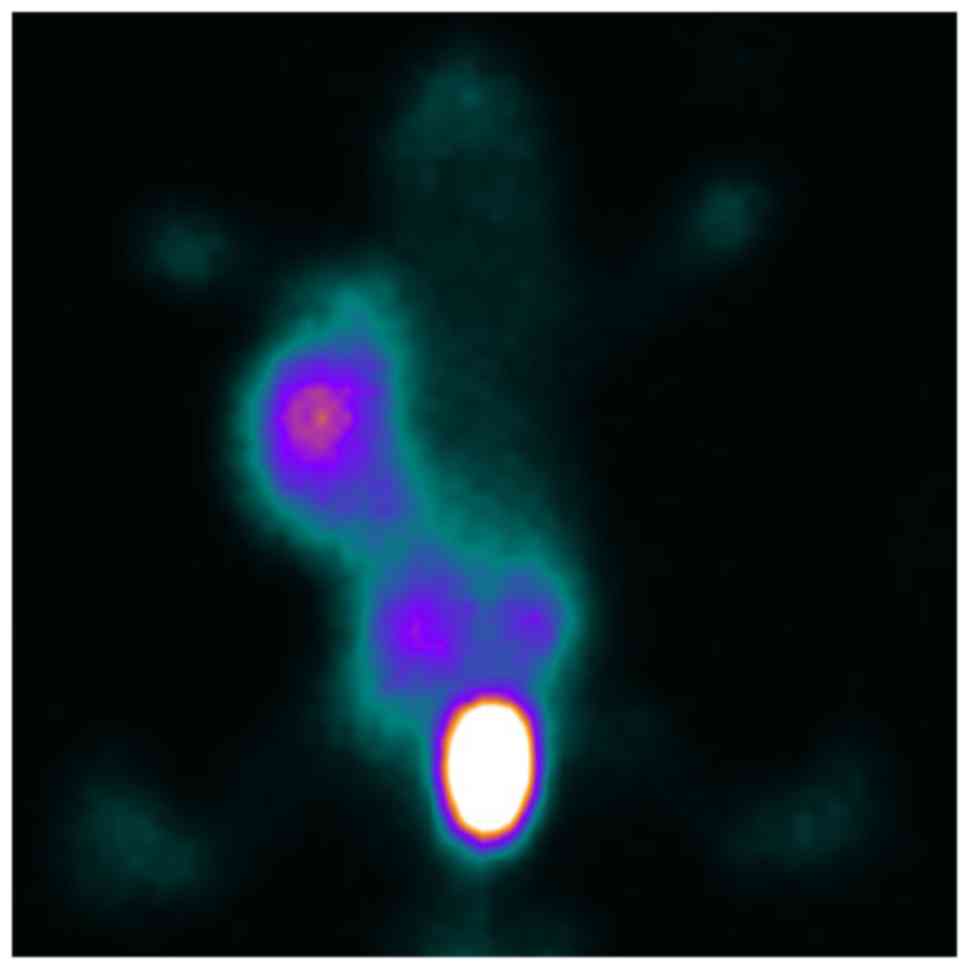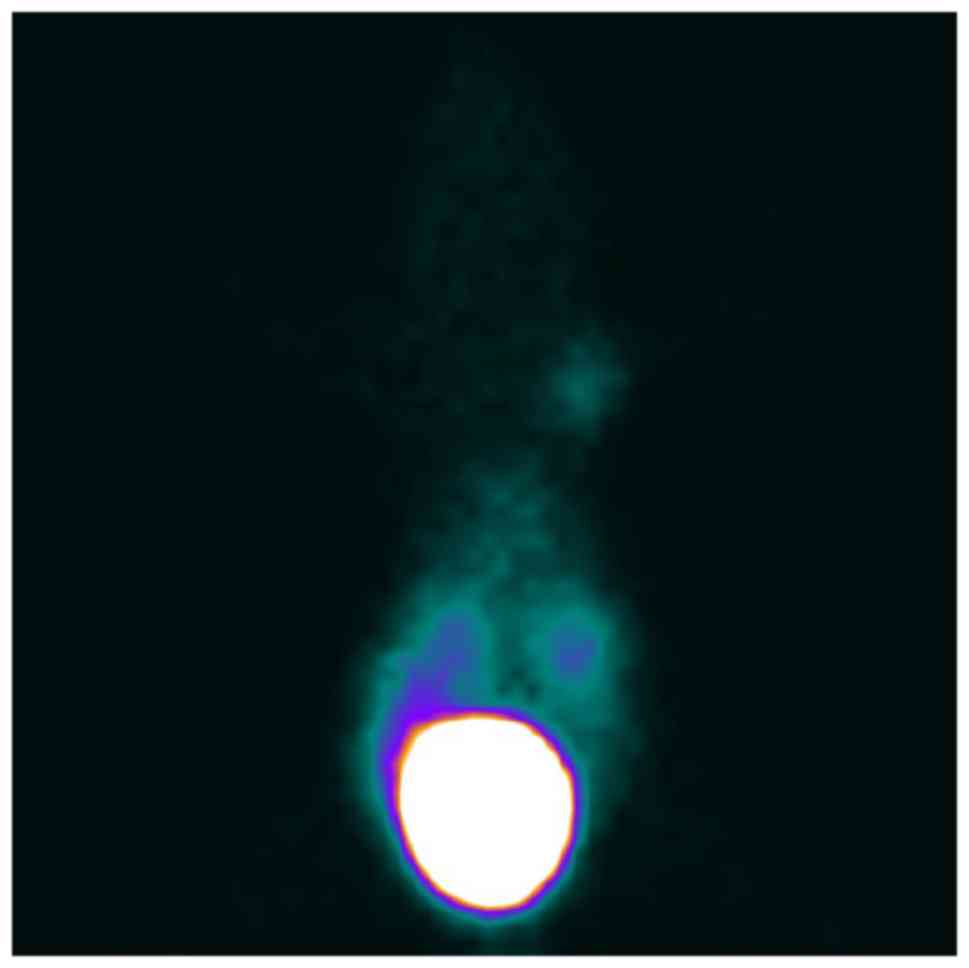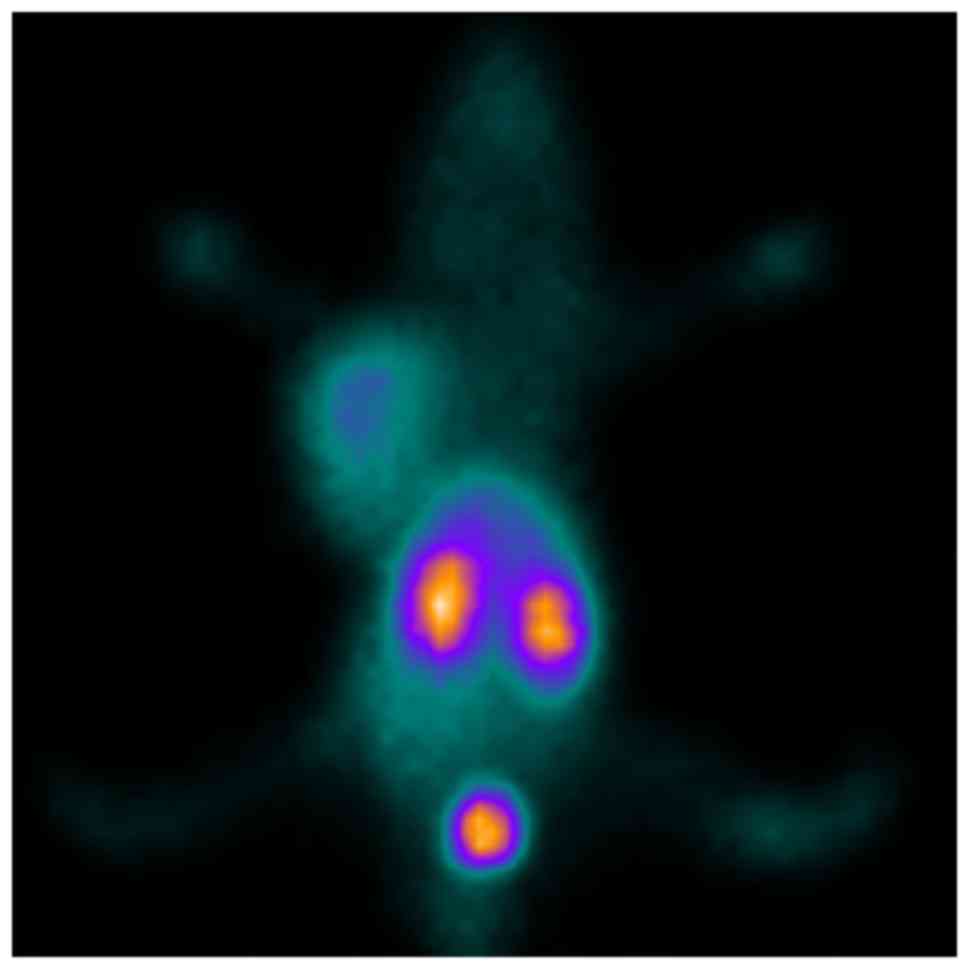Preclinical evaluation of 99mTc direct labeling ZHER2:V2 for HER2 positive tumors imaging
- Authors:
- Published online on: August 8, 2018 https://doi.org/10.3892/ol.2018.9279
- Pages: 5361-5366
Abstract
Introduction
Human epidermal growth factor receptor type 2 (HER2 also known as ErbB2, p185), in which genes located at chromosome 17q21, is one of four members of the ErbB/HER family. The HER2 modulates its activity by a tyrosine kinase signaling pathway, and is involved in the development of many cancers, such as non endocrine tumors (breast, gastric, pancreatic, esophageal, prostate, lung and colon cancers) and few endocrine tumors (thyroid, pituitary, and pheochromocytomas) (1). The HER2 over expression in tumors is responsible for tumor aggressiveness, poor prognosis, decreased survival, and is also associated with enhanced invasiveness and resistance to radiochemotherapy (2,3).
Affibody molecule (Affibody®) consists of 58 amino acids (~6.5 kDa) that contains a modified B domain of the staphylococcal protein A, and it can be obtained via chemical synthesis or produced in bacteria by the use of recombinant DNA technology (4). Because of its small molecule size and high chemical and thermal stability, there are much interested in radiolabeling these molecules and using them for the targeted imaging and treatment of HER2-overexpressing tumors (4–6). ZHER2:342 (~7 kDa) is one of basic Affibody molecule, recently, it has been radiolabeled with 111In or 99mTc and 177Lu, which can be detected HER2-overexpressing tumors under single photon emission computed tomography (SPECT) (7–10). Moreover, ZHER2:342 also could be labeled with 68Ga, 11C, 18F and could be imaged under PET/CT (9,11). However, most of ZHER2:342 radiolabeled results demonstrated the high abdominal accumulation in liver with prolong renal retention, which hampers its application for the detection of abdomen HER2 overexpression tumors (10).
The ZHER2:V2, Affibody molecule of ZHER2:2395-C, based on the ZHER2:342 binding sequence, with C-terminal engineered cysteine (named ZHER2:V2) has been studied recently (12). The structure of ZHER2:V2 is similar with ZHER2:342, only was replaced-AEN at the N-terminal and -GGGC as a chelator at the C-terminal (13). ZHER2:V2 radiolabeled as a probe shows good HER2 tumor target, rapid blood clearance, low levels of stomach and salivary gland radioactivity, low levels of renal radioactivity and low levels of hepatobiliary excretion. Therefore, the radionuclide labeled ZHER2:V2 may be a promising imaging agent for HER2-overexpressing tumors.
The aim of the present study was to label the ZHER2:V2 with 99mTc directly using fast and simple approach and evaluate its properties for HER2 positive tumor imaging: With an eye towards clinical translation.
Materials and methods
Preparation of 99mTc-ZHER2:V2
ZHER2:V2(AEN KFN KEM RNA YWE IAL LPN LNN QQKRAFIRSLYDDPSQSANLLAEAKKLNDAQGGGC) has been assembled by which changing VEN- to AEN- at the N-terminal and the -GGGC as a chelator at the C-terminal (13). ZHER2:V2 was synthesized and purified by Skylight Biotechnology, LLC, (Beijing, China). The labeling method referred to the paper of Tran T and co-authors, and revised the labeling method (14). Briefly, 10 µl of 0.1 M NaOH were added to 10 µl (10 µg) of ZHER2:V2 and the solution pH were adjusted to about 12. Subsequently, 200 µl [111 MBq (3 mCi)] of fresh 99mTcO4- solution obtained from 99Mo/99mTc generator was added, immediately after 0.3 µl (0.3 µg) of SnCl2was added. The mixture solution was incubated for 20 min at 20–25°C room temperature. Finally the pH of the mixture was about 7~8. The labeling efficiency and radiochemical purity of the labeled conjugate were analyzed by reversed-phase high-pressure liquid chromatography (RP-HPLC) with a microbond C18 column (Alltech, model 305, Deerfield IL, 4.6×250 mm) connected a ultraviolet detector, an NaI (Tl) radioactivity monitor, and a rate meter. The C18 column was eluted with a gradient of 5–80% buffer A (0.1% trifluoroacetic acid-CH3CN) and buffer B (0.1% trifluoroacetic acid-H2O) in 20 min and a flow rate of 1 ml/min at 25°C monitoring at 260 nm.
We also analyzed the labeled probe using instant thin layer chromatography (ITLC) method to determine the technetium colloids, ITLC was eluted with acetonitrile. In this eluent, the technetium colloids remained at the origin, while the radiolabeled probe and pertechnetate migrated with solvent front.
In vitro stability analysis
To assess the stability of the radiotracer in vitro, 99mTc-ZHER2:V2 was incubated in physiological saline or human fresh serum at 37°C, and the stability of the radiotracer in vitro was evaluated at 1, 2, 4, 6 and 8 h respectively. The same RP-HPLC conditions were used as those for measuring the release of free pertechnetate.
Cell cultures
The HER2-overexpressing ovarian carcinoma cell line SKOV3 and HER2 low expression breast carcinoma cell line MCF-7 were purchased from the Institute of Cell Biology of the Chinese Academy of Science (Shanghai, China). All cells were cultivated in Roswell Park Memorial Institute 1640 (RPMI 1640) medium supplemented with 10% foetal bovine serum under standard conditions (37°C, humidified atmosphere containing 5% CO2). Cell growth was monitored under inverted microscope with phase contrast. When the cell density reached 90%, the cells were harvested.
Cellular uptake, retention, binding affinity and blocking studies
Sixtuplicate cell wells were used for each data point. The SKOV3 cells were washed twice with phosphate-buffered saline (PBS), then 2 ml of fresh RPMI 1640 medium containing 10% FBS were added, followed by 37 kBq of 99mTc-ZHER2:V2 (0.0001 µg/µl) directly into each well. Cells were harvested by the same trypsin-EDTA solution at 1, 2, 4, 6, 8, 12, and 24 h respectively as described above. Before cell lyses, the medium containing 10% FBS was removed, and the wells were washed twice with PBS. The collected fractions radioactivity was measured using an automated γ counter. Counts the containing radioactive medium and PBS were defined as Cup. After being lysed with 0.5 ml of trypsin-EDTA, 0.5 ml of 10% FBS was added to each well, and then cells were washed twice with PBS. Radioactivity of the lyses solution and PBS were designated as Cdown. The collected fractions radioactivity was measured by an automated γ counter. The cellular uptake ratio was calculated by the formula Cdown/(Cdown + Cup) ×100%.
To determine cellular retention, 99mTc-ZHER2:V2 (37 kBq 0.0001 µg/µl) was directly added into 6-well plates that containing 6×105 SKOV3 cells and incubated at 37°C for 4 h. Then, the medium was removed, and all wells were washed twice with PBS solution. After 2 ml of fresh RPMI 1640 medium containing 10% FBS was added into each well, the plates were incubated at 37°C for 1, 2, 4, 6, 8, 12, and 24 h respectively. The medium containing 10% FBS of the wells was removed before cell lyses, and the wells were washed twice with PBS. The collected fractions radioactivity was measured by an automated γ counter. The cellular retention ratio was calculated by the same formula for calculating cellular uptake kinetics given above. In this way, the radioactivity counts of Cdown contain 99mTc-ZHER2:V2 which have been internalized and membrane-bound.
For internalization studies, 99mTc-ZHER2:V2 uptake was performed as described. Several additional cell plates were used during the binding study to separate the membrane-bound fraction of the conjugate from externalized radioactivity. The wells were washed twice with PBS. Then the isolated cell pellet was washed using 0.2 M acetic acid/0.5 M NaCl, pH 2.5, to remove the cell surface-bound radioactivity at each time point. The radioactivity that was removed from cells by an acidic buffer was defined as membrane-bound.
For blocking studies, 1.5 µg (500 times) or 3 µg (1,000 times) of unlabeled ZHER2:V2 and the 99mTc-ZHER2:V2 were simultaneously added to the cell well. After incubation for 4 h, the 99mTc-ZHER2:V2 uptake of HER2-overexpression SKOV3 cells was measured as the same method that was mentioned above.
Biodistribution studies
All animal studies were performed in accordance with the guidelines of local animal care and use committee. Biodistribution studies of 99mTc-ZHER2:V2 in BALB/c nude mice bearing SKOV3 ×enografts were performed. For biodistribution studies, 0.1 ml 1,110 kBq dose of 99mTc-ZHER2:V2 was injected via the tail vein into the BALB/c nude mice bearing SKOV3 cells (n=4/group), which were sacrificed at 1, 2, 4, or 6 h after the 99mTc-ZHER2:V2 injection. The organ or tissue samples of interest (blood, heart, liver, spleen, kidney, lung, stomach, small intestine, brain, bone, muscle and tumor) were harvested by dissection and weighed. A gamma well counter (CAPRAC®; Capintec Inc., Ramsey, NJ, USA) was used to measure radioactivity uptake in organs or tissues, which was defined as the percentage of injected dose per gram of tissue (%ID/g).
In vivo SPECT imaging studies
Three nude mice were used for (SPECT) imaging. Two mice which bearing SKOV3 ×enografts and MCF-7 ×enografts were respectively injected 37 MBq (100 µl) of 99mTc-ZHER2:V2 (0.003 µg/µl) via the tail vein. The other SKOV3 ×enografts nude mice was injected 30 µg unlabeled ZHER2:V2via tail vein 1 h before the 99mTc-ZHER2:V2 (0.003 µg/µl) was injected 37 MBq (100 µl). After 4 h of injection, animals were anesthetized and placed supine near the centerfield of the view of the SPECT detector and imaged using the e.camduet SPECT equipped with a pinhole collimator. One static anterior image (300,000 counts) was obtained with a zoom 1.78, matrix 128×128 and energy window 140 keV, 15%.
Statistic analysis
Variables were expressed as mean value plus or minus standard deviation (x ± s). Analysis of variance (ANOVA) was used to analyze the variation of cellular uptake in the blocking experiment. P<0.05 was considered to indicate a statistically significant difference.
Results
Radiolabeling of ZHER2:V2
The labeling efficiency was 98.99±0.99% (n=6). 99mTc-ZHER2:V2 using RP-HPLC analysis showed that the retention time was 12 min, with a single, high and sharp peak, which was consistent with its single absorbance peak at 260 nm (Fig. 1) whereas that of the free 99mTc was about 4.5 min (Fig. 2). Even 6 h later the labeling efficiency of 99mTc-ZHER2:V2 was still 97.23%. The result of ITLC showed that the origin has little counts, and almost radioactivity at the front, indicating most of 99mTc have been bound with ZHER2:V2, and almost no technetium colloids existence.
In vitro stability analysis
The results showed that the 99mTc-ZHER2:V2 incubated in physiological saline or human fresh serum at 37°C for 1, 2, 4, 6 and 8 h was very stable in vitro. RP-HPLC analysis demonstrated that the radiochemical purity of 99mTc-ZHER2:V2 was (98.17±1.42%, 98.08±0.94%, 97.81±0.75%, 97.54±0.75%, 96.71±0.51%) and (98.89±0.76%, 98.09±0.57%, 97.87±0.31%, 97.81±0.73%, 96.84±0.69%) respectively. The radiochemical purity of the probe was still as high as 96% even after 6 h, indicating that no significant degradation and off-labeling occurred in human fresh serum or physiological saline at 37°C.
Cellular uptake, retention, binding affinity and blocking studies
The results of cellular uptake 99mTc-ZHER2:V2 studies are presented in Fig. 3. With the interval of time, the cellular uptake was rising slowly, and the peak of cellular uptake ratio appeared at 24 h was 6.15±0.18%. After the peak, the cellular uptake ratio of 99mTc-ZHER2:V2 showed a little decline.
The cell membrane binding rate was showed in Fig. 4, indicating that the cell membrane binding is a rapid process in SKOV3 cells, greater than 85.5% of the radioactivity was bound on the cell membrane after incubating 99mTc-ZHER2:V2 with SKOV3 cells, and after 24 h later, there were almost 70% 99mTc-ZHER2:V2 sill binding on cell membrane. As a result, the 99mTc-ZHER2:V2 has a slowly internalizing course characterize.
The result of retention kinetics analysis was shown in Fig. 5. The results demonstrated good 99mTc-ZHER2:V2 retention in SKOV3 cells, with 48.58±4.52% at 6 h, even after 24 h, the retention ratio of 99mTc-ZHER2:V2 still reached 35.16±11.23%.
The specific binding of 99mTc-ZHER2:V2 in SKOV3 cells was shown in Fig. 6, the 99mTc-ZHER2:V2 was blocked by an excess amount (500 or 1,000 times) of unlabeled ZHER2:V2 in SKOV3 cells (F=351.232, P<0.05). In addition, 99mTc-ZHER2:V2 was significantly blocked when 1,000 times of unlabeled ZHER2:V2 were added as compared with that of 500 times of unlabeled ZHER2:V2 in SKOV3 cells, demonstrating the character of HER2-specific binding.
Biodistribution studies
99mTc-ZHER2:V2 biodistribution analysis was performed in nude mice bearing SKOV3 ×enografts at 1, 2, 4, and 6 h after intravenous injection. Data on the biodistribution of the SKOV3 ×enografts are presented in Table I. The results revealed low uptake of radioactivity in all organs except kidneys (8.68±2.68% ID/g) and tumor. The other samples were <2% ID/g except the liver (2.70±0.17% ID/g). The radioactive uptake in SKOV3 ×enografts was higher than that for organs other than the kidneys. The tumor accumulation was 4.14±1.61, 6.47±2.09, 5.04±2.58, 10.07±0.33% ID/g at 1, 2, 4 and 6 h, respectively. The radioactivity in all organs was reduced as time gone by other than the tumor, demonstrating good specificity and sensitivity of 99mTc-ZHER2:V2 in the detection of HER2 receptors.
In vivo SPECT imaging studies
After injection of 99mTc-ZHER2:V2 in nude mice bearing SKOV3 ×enograft via the tail vein, the images revealed intense tracer uptake in the tumor (Fig. 7) and the T/NT ratios was 9.98 at 4 h after injection, while the MCF-7 ×enograft has low tracer accumulated (Fig. 8) and the T/NT ratios was 3.79, indicating 99mTc-ZHER2:V2 could be highly uptake by HER2-overexpression tumors, and further proved the probe HER2-specific binding. The kidneys also accumulated a lot of 99mTc-ZHER2:V2 radioactivity, however, little radioactivity stay in the liver, indicating that the 99mTc-ZHER2:V2 radioactivity was removed mainly through the renal routes and decreased gradually throughout the body. And the SKOV3 ×enografts imaging can be blocked by excess amount unlabelled ZHER2:V2 at 2 h after injection of the tracer (Fig. 9).
Discussion
Recently, HER2-receptor imaging has been developed as a method to detect tumor HER2-overexpression, and it can revealed important molecular clues for cancer patient management.
Molecular imaging is an advance imaging that can visually characterize, represent, and quantify biologic processes at the cellular or subcellular level. In previous studies, researchers used 64Cu-MM-302 (15) and 18F-ZHER2:342 (11) proved to be potential for PET HER2 imaging. But these radiotracers have some limitations: 18F labeling peptide requires an in-house cyclotron system, a complex infrastructure, a time-consuming synthesis procedure and tedious purification; 64Cu-DOTA conjugates generally display high liver accumulation because of the possible off-labeling of 64Cu from the chelator (15).
99mTc has been successfully labeled on Affibody molecule and its derivatives. As is widely known, it is a complicated process that 99mTc was labeled on peptides, ‘incubate in boiling water’ was used in most of previous studies (10,16,17). In this study, direct labeling method was performing: NaOH was added to adjust the PH and SnCl2 as the reluctant of 99mTc, not incubated in boiling water but in room temperature. As a result, the labeling efficiency was exceeding 98%. This labeling approach is similar with Tran and co-authors (14), and the labeling efficiency has no difference (98.99% vs. 98.1%). These results indicated that this revised labeling method is very good.
Direct labeling has a disadvantage of yielding technetium colloids, to avoid this situation, how many SnCl2 were added is the important. In this study, 99mTc were almost labeled on ZHER2:V2 and technetium colloids were yielded hardly. And from the ITLC test, outcome showed that no technetium colloids were yielded.
At present, lots of studies on the 99mTc labeled HER2 molecular probes to image the HER2-overexpression tumors in vivo have been performed. But from the biodistribution studies, the results demonstrated that there were a high level hepatic accumulation of radioactivity and a prolong renal retention (16–19). A high level of hepatic accumulation reduces the imaging sensitivity and may obstruct the detection of liver metastases, and an elevated renal uptake was hindering the detection of metastases in the lumbar and abdomen area. Thus, it is very important to improve the probe tumor uptake and decrease liver and kidneys uptake as much as possible.
Some of previous studies demonstrated that the amino acid consists of the N-terminal was significant for the biodistribution in terms of liver accumulation and the extent of hepatobiliary excretion. Scholars agreed on that N-terminal chelator contains amino acids with hydrophilic (polar or charged) side chains could reduced liver accumulation and had low hepatobiliary excretion (18,20–23), whereas the consists of the C-terminal was shown to be less influential in that aspect (24). Furthermore, validation experiments showed that Ala, Glu at the N-terminal was associated with low hepatic uptake and low hepatobiliary excretion (16,22,23,25). In the present study of biodistribution, the results showed the low hepatic uptake of 99mTc-ZHER2:V2, and the liver hardly seen from molecular image.
Our intriguing findings were further confirmed by the vivo research outcome. The images of nude mice bearing HER2-overexpression SKOV3 ×enograft was seen clearly and the tumor showed a significant contrast compared to other organs, on the contrary, the images of nude mice bearing HER2 low expression MCF-7 ×enograft showed few of 99mTc-ZHER2:V2 uptake. These demonstrated that the 99mTc-ZHER2:V2 was significantly uptake by HER2-overexpression tumors. The vitro and vivo blocking study showed that HER2-overexpression SKOV3 cells uptake 99mTc-ZHER2:V2 can be successfully blocked using excess amount unlabeled ZHER2:V2. These results further revealed binding specificity of HER2-recptors of 99mTc-ZHER2:V2. Moreover, radioactivity accumulation in liver was limited which illustrates that using-GGGC as a chelator at C-terminal could be reduced the hepatic uptake.
In conclusion, 99mTc-ZHER2:V2 can be labeled simply and quickly in directly labeling method, with good labeling yield and radiochemical purity. It is easy for 99mTc-ZHER2:V2 kit formulation. 99mTc-ZHER2:V2 can specifically and efficiently target HER2-overexpressing tumors with promising sensitivity and specificity. We strongly anticipate that it may be a promising probe for clinical translation to detect HER2-overexpression tumors.
Acknowledgements
The authors would like to acknowledge the assistance of all coworkers involved in the study. The present study was supported by the National Natural Science Foundation of China (NSFC) project (81571702) and Hebei Province Government Founding for Clinical Excellent Talent Project (2016).
Competing interests
The authors declare that they have no competing interests.
References
|
Goebel SU, Iwamoto M, Raffeld M, Gibril F, Hou W, Serrano J and Jensen RT: HER-2/neu expression and gene amplification in gastrinomas: Correlations with tumor biology, growth and aggressiveness. J Cance Res. 62:3702–3710. 2002. | |
|
Slamon DJ, Clark GM, Wong SG, Levin WJ, Ullrich A and McGuire WL: Human breast cancer: Correlation of relapse and survival with amplification of the HER-2/neu oncogene. Science. 235:177–182. 1987. View Article : Google Scholar : PubMed/NCBI | |
|
Chen JS, Lan K and Hung MC: Strategies to target HER2/neu overexpression for cancer therapy. Drug Resist Updat. 6:129–136. 2003. View Article : Google Scholar : PubMed/NCBI | |
|
Feldwisch J, Tolmachev V, Lendel C, Herne N, Sjöberg A, Larsson B, Rosik D, Lindqvist E, Fant G, Höidén-Guthenberg I, et al: Design of an optimized scaffold for affibody molecules. J Mol Biol. 398:232–247. 2010. View Article : Google Scholar : PubMed/NCBI | |
|
Löfblom J, Feldwisch J, Tolmachev V, Carlsson J, Ståhl S and Frejd FY: Affibody molecules: Engineered proteins for therapeutic, diagnostic and biotechnological applications. FEBS Lett. 584:2670–2680. 2010. View Article : Google Scholar : PubMed/NCBI | |
|
Tolmachev V and Orlova A: Influence of labeling methods on biodistribution and imaging properties of radiolabeled peptides for visualisation of molecular therapeutic targets. Curr Med Chem. 17:2636–2655. 2010. View Article : Google Scholar : PubMed/NCBI | |
|
Orlova A, Feldwisch J, Abrahmsen L and Tolmachev V: Update: Affibody molecules for molecular imaging and therapy for cancer. Cancer Biother Radiopharm. 22:573–584. 2007. View Article : Google Scholar : PubMed/NCBI | |
|
Price EW, Zeglis BM, Cawthray JF, Ramogida CF, Ramos N, Lewis JS, Adam MJ and Orvig C: H(4)octapa-trastuzumab: Versatile acyclic chelate system for 111In and 177Lu imaging and therapy. J Am Chem Soc. 135:12707–12721. 2013. View Article : Google Scholar : PubMed/NCBI | |
|
Wållberg H, Grafström J, Cheng Q, Lu L, Martinsson Ahlzén HS, Samén E, Thorell JO, Johansson K, Dunås F, Olofsson MH, et al: HER2-positive tumors imaged within 1 hour using a site-specifically 11C-labeled Sel-tagged affibody molecule. J Nucl Med. 53:1446–1453. 2012. View Article : Google Scholar : PubMed/NCBI | |
|
Zhang JM, Zhao XM, Wang SJ, Ren XC, Wang N, Han JY and Jia LZ: Evaluation of 99mTc-peptide-ZHER2:342 Affibody® molecule for in vivo molecular imaging. Br J Radiol. 87:201304842014. View Article : Google Scholar : PubMed/NCBI | |
|
Kramer-Marek G, Bernardo M, Kiesewetter DO, Bagci U, Kuban M, Aras O, Zielinski R, Seidel J, Choyke P and Capala J: PET of HER2-positive pulmonary metastases with 18F-ZHER2:342 affibody in a murine model of breast cancer: Comparison with 18F-FDG. J Nucl Med. 53:939–946. 2012. View Article : Google Scholar : PubMed/NCBI | |
|
Engfeldt T, Orlova A, Tran T, Bruskin A, Widström C, Karlström AE and Tolmachev V: Imaging of HER2-expressing tumours using a synthetic Affibody molecule containing the 99mTc-chelating mercaptoacetyl-glycyl-glycyl-glycyl (MAG3) sequence. Eur J Nucl Med Mol Imaging. 34:722–733. 2007. View Article : Google Scholar : PubMed/NCBI | |
|
Wållberg H, Orlova A, Altai M, Hosseinimehr SJ, Widström C, Malmberg J, Ståhl S and Tolmachev V: Molecular design and optimization of 99mTc-labeled recombinant affibody molecules improves their biodistribution and imaging properties. J Nucl Med. 52:461–469. 2011. View Article : Google Scholar : PubMed/NCBI | |
|
Tran T, Engfeldt T, Orlova A, Widström C, Bruskin A, Tolmachev V and Karlström AE: In vivo evaluation of cysteine-based chelators for attachment of 99mTc to tumor-targeting Affibody molecules. Bioconjug Chem. 18:549–558. 2007. View Article : Google Scholar : PubMed/NCBI | |
|
Lee H, Zheng J, Gaddy D, Orcutt KD, Leonard S, Geretti E, Hesterman J, Harwell C, Hoppin J, Jaffray DA, et al: A gradient-loadable (64)Cu-chelator for quantifying tumor deposition kinetics of nanoliposomal therapeutics by positron emission tomography. Nanomedicine. 11:155–165. 2015. View Article : Google Scholar : PubMed/NCBI | |
|
Ahlgren S, Wållberg H, Tran TA, Widström C, Hjertman M, Abrahmsén L, Berndorff D, Dinkelborg LM, Cyr JE, Feldwisch J, et al: Targeting of HER2-expressing tumors using a site-specifically 99mTc-labeled recombinant Affibody molecule, ZHER2:2395, with C-terminal engineered cysteine. J Nucl Med. 50:781–789. 2009. View Article : Google Scholar : PubMed/NCBI | |
|
Orlova A, Nilsson FY, Wikman M, Widström C, Ståhl S, Carlsson J and Tolmachev V: Comparative in vivo evaluation of iodine and technetium labels on anti-HER2 Affibody for single-photon imaging of HER2 expression in tumors. J Nucl Med. 47:512–519. 2006.PubMed/NCBI | |
|
Tolmachev V, Hofström C, Malmberg J, Ahlgren S, Hosseinimehr SJ, Sandström M, Abrahmsén L, Orlova A and Gräslund T: HEHEHE-tagged affibody molecules may be purified by IMAC, are conveniently labeled with [99(m)Tc(CO)3](+), and show improved biodistribution with reduced hepatic radioactivity accumulation. Bioconjug Chem. 21:2013–2022. 2010. View Article : Google Scholar : PubMed/NCBI | |
|
Ahlgren S, Orlova A, Rosik D, Sandström M, Sjöberg A, Baastrup B, Widmark O, Fant G, Feldwisch J and Tolmachev V: Evaluation of maleimide derivative of DOTA for site-specific labeling of recombinant Affibody molecules. Bioconjug Chem. 19:235–243. 2008. View Article : Google Scholar : PubMed/NCBI | |
|
Tran T, Engfeldt T, Orlova A, Sandström M, Feldwisch J, Abrahmsén L, Wennborg A, Tolmachev V and Karlström AE: (99m)Tc-maEEE-Z(HER2:342), an Affibody molecule-based tracer for detection of HER2 expression in malignant tumors. Bioconjug Chem. 18:1956–1964. 2007. View Article : Google Scholar : PubMed/NCBI | |
|
Ekblad T, Tran T, Orlova A, Widström C, Feldwisch J, Abrahmsén L, Wennborg A, Karlström AE and Tolmachev V: Development and preclinical characterization of 99mTc-labeled Affibody molecules with reduced renal uptake. Eur J Nucl Med Mol Imaging. 35:2245–2255. 2008. View Article : Google Scholar : PubMed/NCBI | |
|
Tran TA, Ekblad T, Orlova A, Sandström M, Feldwisch J, Wennborg A, Abrahmsén L, Tolmachev V and Eriksson Karlström A: Effects of lysine-containing mercaptoacetyl-based chelators on the biodistribution of 99mTc-labeled anti-HER2 Affibody molecules. Bioconjug Chem. 19:2568–2576. 2008. View Article : Google Scholar : PubMed/NCBI | |
|
Engfeldt T, Tran T, Orlova A, Widström C, Feldwisch J, Abrahmsen L, Wennborg A, Karlström AE and Tolmachev V: 99mTc-chelator engineering to improve tumour targeting properties of a HER2-specific Affibody molecule. Eur J Nucl Med Mol Imaging. 34:1843–1853. 2007. View Article : Google Scholar : PubMed/NCBI | |
|
Tran T, Engfeldt T, Orlova A, Sandström M, Feldwisch J, Abrahmsén L, Wennborg A, Tolmachev V and Karlström AE: (99m)Tc-maEEE-Z(HER2:342), an Affibody molecule-based tracer for detection of HER2-expression in malignant tumors. Bioconjug Chem. 18:1956–1964. 2007. View Article : Google Scholar : PubMed/NCBI | |
|
Tran TA, Rosik D, Abrahmsén L, Sandström M, Sjöberg A, Wållberg H, Ahlgren S, Orlova A and Tolmachev V: Design, synthesis and biological evaluation of a HER2-specific affibody molecule for molecular imaging. Eur J Nucl Med Mol Imaging. 36:1864–1873. 2009. View Article : Google Scholar : PubMed/NCBI |



